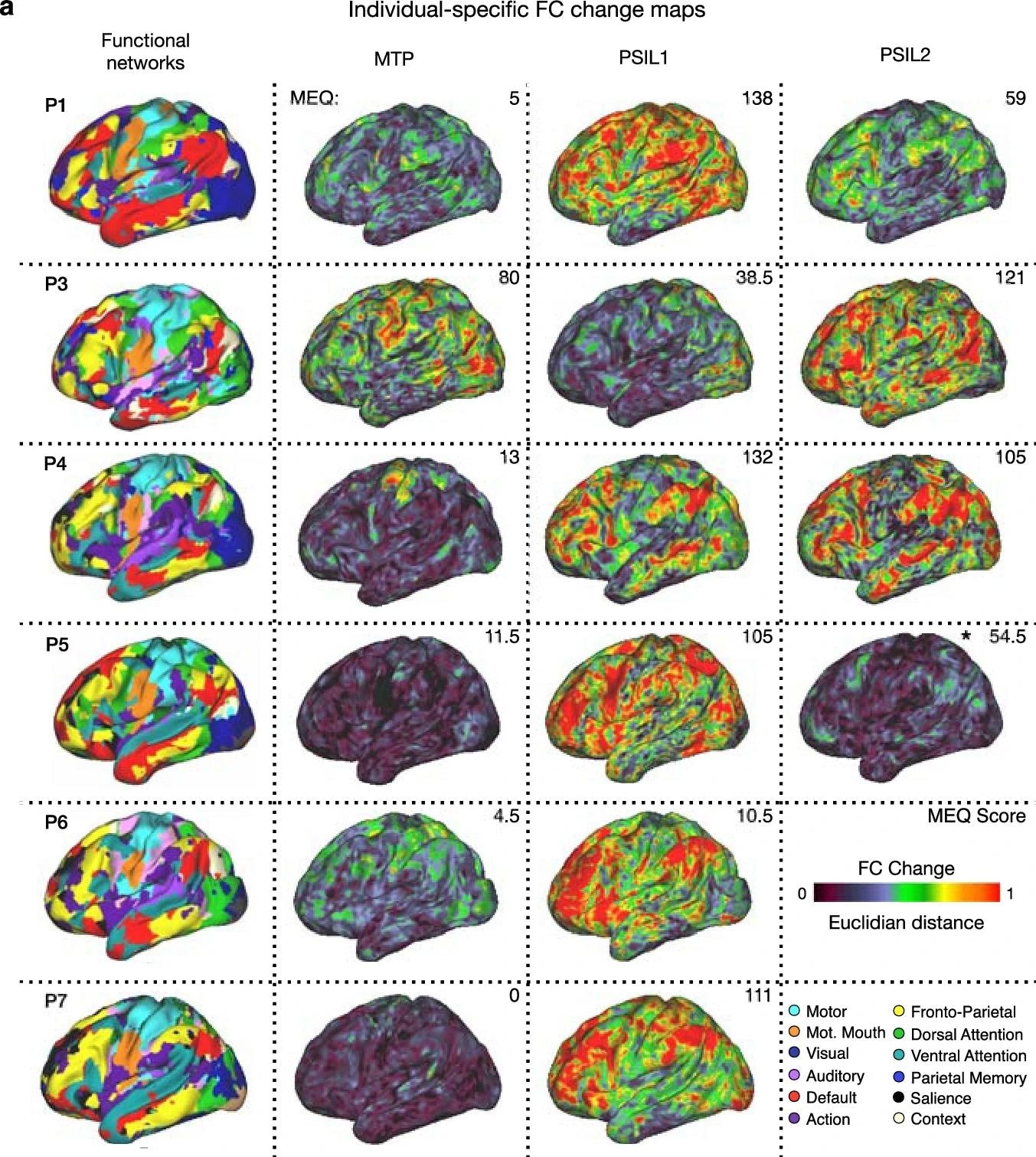In a recent study published in the journal Nature, researchers in the United States of America tracked brain changes in healthy adults prior to, during, and after administration of high-dose psilocybin, a psychedelic drug, and compared it to methylphenidate (MTP), a control drug. They found that psilocybin caused significant disruptions in brain functional connectivity (FC), particularly in the default mode network, linked to subjective experiences and lasting for weeks, which may underlie its therapeutic effects.

Individual participant methylphenidate (MTP) and psilocybin (PSIL) FC change maps. Left most column shows individuals’ functional networks. Right 3 columns show FC change maps, generated by calculating Euclidean distance from baseline seedmaps for each vertex. For each session the total score on the Mystical Experience Questionnaire (MEQ30: out of a maximum of 150) is given in the upper right corner. *P5 had an episode of emesis 30 minutes after drug ingestion during PSIL2. Study: Psilocybin desynchronizes the human brain
Background
Psychedelic drugs like psilocybin, through serotonin 2A (5-HT2A) receptor activation, induce significant acute and persistent changes in self, time, and space perception. Clinical trials show that a single high dose of this drug can provide rapid, lasting relief for conditions like depression, addiction, and anxiety. In rodents, psilocybin promotes neuronal communication and plasticity in regions rich in 5-HT2A receptors, such as the medial frontal lobe. However, human-specific effects remain unclear. In humans, psilocybin affects brain signaling, metabolism, and network segregation, but the mechanisms are poorly understood, especially in the subcortex. Notably, the default mode network (DMN) and its connectivity with the hippocampus play a role in depression and treatment response.
Precision functional mapping using repeated functional magnetic resonance imaging (fMRI) scans helps track individual-specific brain changes, highlighting the stability and variability of brain networks. In the present study, researchers used precision functional mapping in healthy young adults to investigate the effects of the administration of psilocybin and methylphenidate on the human brain.
About the study
In the present randomized cross-over study, healthy adults aged 18–45 years (n = 7) were included to evaluate brain connectivity changes before, during, and after psilocybin exposure. Participants with at least one prior lifetime exposure to psychedelics (e.g., psilocybin, mescaline, ayahuasca, LSD) but no psychedelic use within the past six months were included. Individuals with psychiatric illnesses such as depression, psychosis, or addiction, as defined by the DSM-5, were excluded.
The included individuals underwent MRI sessions every other day after ingesting 25 mg psilocybin or 40 mg MTP, a control drug mimicking psilocybin's cardiovascular and dopaminergic effects. Imaging sessions (roughly 18 per participant) occurred at baseline, during, between, and after drug administration. Structural and functional MRI data were collected, including resting-state and task-based scans. Primary outcomes focused on brain network connectivity changes. Additionally, secondary outcomes included hemodynamic responses, acute psychological effects using MEQ30 (short for mystical experience questionnaire) scores, and pulse or respiratory rates. Participants returned 6–12 months after the initial study for a replication protocol.
Results and discussion
Psilocybin administration significantly changed brain FC across the cerebral cortex, especially in association networks. The most significant changes were in DMN-connected areas of the thalamus, cerebellum, basal ganglia, and anterior hippocampus. MTP's FC changes were localized to sensorimotor systems and reflected day-to-day variability, likely due to arousal effects. Despite similar heart rate increases, psilocybin's FC effects were found to be over three times larger than MTP's and comparable to individual brain differences.
The study linked subjective psychedelic experiences with brain function data, finding that FC changes during psilocybin sessions correlated strongly with experience intensity. Head motion was not found to be a significant factor. Further, psilocybin was found to increase FC between networks and decrease within-network FC, similar to nitrous oxide and ketamine. In contrast, MTP decreased within-network FC in sensory, motor, and auditory regions, similar to caffeine.
Psilocybin caused the desynchronization of neuron populations by agonizing 5-HT2A receptors, leading to increased spatial entropy or normalized global spatial complexity (NGSC). Psilocybin significantly elevated NGSC, indicating greater brain signal desynchronization, which correlated with the subjective psychedelic experience and returned to baseline in subsequent sessions. This effect was observed both globally and in specific brain areas, particularly the association cortex. Similar NGSC increases were found with LSD, suggesting a common mechanism across psychedelics. During a task, psilocybin's impact on brain desynchronization and network disruption was significantly reduced, indicating that task engagement mitigates psilocybin-induced changes. The reduction in desynchronization during tasks aligns with the psychological principle of 'grounding,' used in psychedelic therapy to alleviate distress.
Following psilocybin administration, whole-brain FC largely returned to baseline within 3 weeks, but persistent decreases in FC were noted in the anterior hippocampus, particularly in its connectivity with the DMN. No significant persistent FC changes were observed after MTP. This observation reflects potential neuroplasticity associated with psilocybin-induced synaptogenesis.
Overall, psilocybin induces profound brain desynchronization, reflecting a radical shift in consciousness beyond mere arousal effects. This desynchronization potentially bridges micro-scale neuronal changes with macro-scale network disruptions and may drive both acute and persistent neuroplastic changes.
Conclusion
In conclusion, the study reveals that psilocybin causes significant and persistent changes in brain FC, particularly affecting the DMN and hippocampus, with lasting desynchronization aligning with subjective experiences. These alterations suggest that psilocybin induces neuroplasticity, contributing to its therapeutic effects. Further research in clinical settings is needed to confirm psilocybin's antidepressant potential to refine precision medicine approaches.